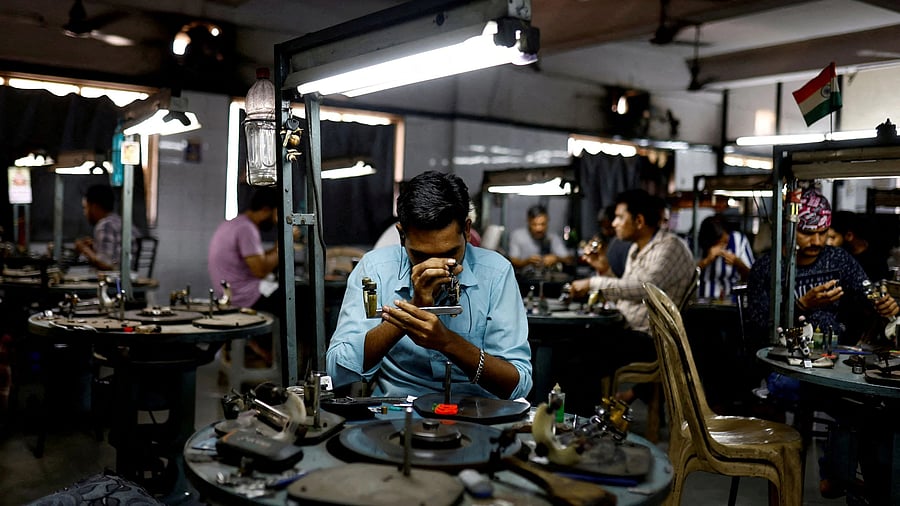
Craftsmen work on diamonds inside a diamond processing unit in Surat.
REUTERS file photo
New Delhi: The United States has notified an additional 25% duty on Indian goods effective August 27, taking the overall tariff to a steep 50%, a move that may virtually push a vast majority of Made-in-India products off the American shelves.
The new duties will apply to Indian goods entering the US for consumption or withdrawn from warehouses for consumption from August 27 (9.31 am IST August 28), as per a notice issued by the US Homeland Security.
A so-called “reciprocal” 25% tariff is already in force since August 1. The new tariff will take the total to 50%. This will erode competitiveness of Indian exporters as the competitors like Vietnam, Bangladesh, Indonesia, Japan and China face much lower duty.
The new duty is likely to further strain India-US relations. The US Homeland Security notice on India tariff was released hours after Prime Minister Narendra Modi asserted that India would not compromise on the interests of farmers, small entrepreneurs and livestock rearers.
While India’s economy is largely domestic consumption-driven, different analysts peg 0.2% to 1% hit to India’s GDP due to the tariff.
Rating agency Fitch said the uncertainty over the US tariff would weigh on business sentiment and investment. This is likely to make hundreds of thousands of people jobless, especially in labour-intensive sectors like textiles, leather, footwear and gems and jewellery.
Industries like leather, ceramics, chemicals, handicrafts and carpets will also face a sharp erosion of competitiveness, particularly against European, South-East Asia and Mexican producers.
“Delays, order cancellations and negated cost advantages loom large on these sectors,” said FIEO President S C Ralhan.
However, pharmaceuticals, electronics and petroleum products are spared for now. Aluminium, steel/iron and copper, which currently face 25% duty, are also exempt from the additional 25%.
According to the Federation of Indian Export Organisations (FIEO), textiles and apparel manufacturers in Tiruppur, Noida and Surat have halted production amid worsening cost competitiveness in the US. With higher tariff, this sector will lose ground to lower‑cost rivals from Vietnam and Bangladesh.
“India’s products will lose competitiveness and potentially benefiting countries like China and Vietnam, as tariff imposed on India is also higher than on other Asian countries such as China (30%), Vietnam (20%), Indonesia (19%), and Japan (15%),” said SBI Research in a note.
Around $47-48 billion worth of India’s US-bound shipments are now exposed to pricing disadvantages of 30–35%, rendering them uncompetitive in comparison to its competitors, said FIEO President Ralhan.
As per an analysis by the Global Trade Research Initiative (GTRI), India’s exports to the US were valued at $86.5 billion in 2024-25. Out of this, around $60.2 billion (66%) will now face the 50% tariff. Another $3.4 billion in auto parts remains at 25%, while $27.6 billion, mostly pharma, electronics and petroleum, stays duty-free.
“This is a strategic shock that threatens India’s long-standing foothold in US labour-intensive markets, risks mass unemployment in export hubs, and could weaken India’s participation in global value chains,” said GTRI founder Ajay Srivastava.
“Competitors like China, Vietnam, Mexico, Turkey, and even Pakistan, Nepal, Guatemala, and Kenya stand to gain, potentially locking India out of key markets even after tariffs are rolled back,” he added.